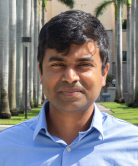To better monitor marine particles, like microscopic plants and animals called plankton, Aditya Nayak, Ph.D., assistant professor in the department of ocean and mechanical engineering in the College of Engineering and Computer Science, and collaborators, have developed a type of 3D microscope, which has a pending patent application.
Nayak is interested in developing and using novel ocean technologies to help understand fundamental questions related to ocean physics and marine ecology. His current research goals are focused around developing imaging systems to study marine plankton, and their interactions with the surrounding environment. “These have consequences to important topics including monitoring marine ecosystem health and climate change,” said Nayak, who has a joint appointment with the FAU Harbor Branch Oceanographic Institute.
Before joining FAU, he earned his doctorate and master’s degrees in mechanical engineering at Johns Hopkins University in Maryland. He earned a bachelor’s degree in mechanical engineering from the National Institute of Technology Karnataka, Surathkal, India.
How did you first become interested in ocean instrumentation?
I first became involved with ocean-related research as part of my doctorate work, where I used imaging tools to understand small-scale flow patterns in the coastal ocean, with relevance to coastal engineering and sediment transport applications. During my postdoc, the focus expanded to designing instrumentation to characterize oceanic particle and plankton distributions as well as their interactions with the local flow, with implications to marine ecology and ocean optics. I have been working in this broad area ever since.
How do you see your research benefiting the public?
Our research in developing in situ imaging tools has broad applications to marine plankton research and can lead to a better understanding of marine ecosystems and ocean health (and consequently, human health). An example is in monitoring harmful algal blooms (HABs) in diverse environments, where rapid detection of these species is important to issue public alerts.
What is your most interesting research accomplishment?
The development of our in situ holographic imaging system, which can be thought of as a 3-D microscope, has opened new avenues for plankton monitoring. Recently, we successfully demonstrated its application towards the rapid detection of Karenia brevis - the red tide causing organism – in the Gulf of Mexico. We are currently working on expanding the applications in HAB monitoring to other regions, including Lake Erie in Michigan.
What new developments and innovations can we expect to see in your research in the next five years?
Advances in computing capabilities, as well as artificial-intelligence-based classification, are paving the way for miniaturization of in situ imaging systems as well as rapid onboard data processing. Traditionally, the main bottleneck for rapid data dissemination from in situ imaging systems, has been the large file sizes. Onboard processing and image analysis to simplify data outputs can facilitate rapid transmission and circumvent this issue.
Talk about your experience with the FAU Division of Research Office of Technology Development (OTD) in regards to applying for your patent.
My experience with OTD has been fantastic so far. Dana (Vouglitois, associate director, OTD) has been instrumental in all aspects of the invention process, helping us file both the provisional and full patents for our in situ holographic imaging system, marketing our product to potential commercial partners and facilitating meetings with them. I have learned a lot through this process and hope to keep this relationship with OTD going for a long time to come.
Aside from research, what are some of your hobbies and interests?
I enjoy birding and faithfully keep a life list — 386 species to date, across four countries and three continents if anyone is interested.
